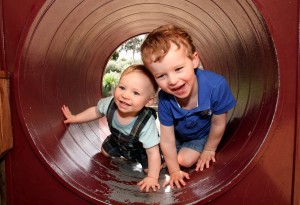How to Stimulate Your Infant’s Play
How to Stimulate Your Infant’s Play
 As a grandma of infant twin baby girls, I spend hours caring and observing their various playful antics and needs in stimulating play activities. During the first six months, infants focus their days on eating, sleeping, and exploring their world with lots of loving cuddles. As your baby becomes more mobile by rolling, crawling, pulling up, and starting to walk, you can set up stimulating play areas to encourage exploration and redirect your baby from forbidden and dangerous explorations (i.e. extension cords, outlets, and small furniture that can topple on baby). These stimulating play areas can contribute to your baby’s cognitive, social-emotional, and large muscle growth. Babies love to move around and experience their environment. They love to play with their toys in boxes, laundry baskets, bassinets that have been transformed into toy holders, containers, and cabinets. Babies need toys that are safe and that reinforce cause and effect. Suggested toys for this age group can include any of the following:
As a grandma of infant twin baby girls, I spend hours caring and observing their various playful antics and needs in stimulating play activities. During the first six months, infants focus their days on eating, sleeping, and exploring their world with lots of loving cuddles. As your baby becomes more mobile by rolling, crawling, pulling up, and starting to walk, you can set up stimulating play areas to encourage exploration and redirect your baby from forbidden and dangerous explorations (i.e. extension cords, outlets, and small furniture that can topple on baby). These stimulating play areas can contribute to your baby’s cognitive, social-emotional, and large muscle growth. Babies love to move around and experience their environment. They love to play with their toys in boxes, laundry baskets, bassinets that have been transformed into toy holders, containers, and cabinets. Babies need toys that are safe and that reinforce cause and effect. Suggested toys for this age group can include any of the following:
- Rattles, plastic teething rings, and plastic toys that baby can shake and make different noises
- Cuddly animals and dolls that babies can hug as friends
- Balls that baby can roll and make noises or different types of music
- Wonder wands that sift sand, shake bells, mix colors, or roll jumbo marbles
- Wooden toys that can be pushed or pulled or have moving parts with different sounds
- Activity boxes with various levers, beads, or cylinders that have different sounds when completing an activity
- Toys that have tracks for beads and objects that can be moved in different directions
- Fabric books and board books that are easy for baby to turn pages and may include flaps, textures, and sounds
- Toys with activity mirrors
- Music boxes, toy telephones with sounds, and toy radios
- Stacking boxes, stacking cups, and tubes with stacking rings
- Soothing animals and rattles that attach to crib and play comforting sounds and music
- Cubes, tubes, and tunnels babies can crawl though
- Swings, a Johnny Jump Up, and activity tables
- Wooden jumbo blocks, cars, airplanes and boats
- Musical instruments and toys that can be played with to make different sounds
- Bath and water play toys for pouring water, sinking, and floating
When playing with your baby, you can mix a combination of toys and activities to balance the day for various types of explorations. After the morning feeding, your infant should be well rested and may enjoy exploring different combinations of toys and activities until the morning nap. You may want to integrate large muscle activities with reading stories or singing songs. After the morning nap, your baby may want to play in another area of the house with a different mix of toys and organized play areas while you complete your daily chores. Lunch can be integrated with more singing, stories, or music. After lunch and before the afternoon nap, you may want to have your infant play in the Johnny Jump Up or participate in a similar large muscle activity toy to prepare your baby for a good afternoon nap. After nap, you may want to spend the afternoon with your baby going to a park, swinging, taking a stroller ride and looking at nature, crawling outside on a play mat, or playing outside with an activity table. After dinner, your baby may be happiest listening to music while playing with family members or looking at books. Our twin granddaughters prefer reading and playing with learning activities in the morning. They love to play with their family and act silly at night before bed. Baths for babies can be very calming for before bed along with cuddle time and a story.
Baby music time throughout the day can include listening and dancing to music on the radio, television, or on a mobile device. Babies love to dance and shake their bodies. They love to make noise with their toys and rattles. Babies love to hear you sing and will babble back and bounce with you when you sing. Eventually they will imitate your actions and try and clap their hands, pat their heads, and swing their arms on command along with touching the various parts of their body. The rhythm and rhyming of music is very stimulating to babies and supports their differentiation of sounds and language development. Adding scarfs, a parachute, and other sensory experiences to music expands this stimulating play experience.
Although there are a multitude of playful and sensory activities that you can enjoy with your baby, watch or listen to your baby’s responses to various stimulating activities to determine which activities are best for both of you to share together as treasured playful moments.
Happy stimulating play with your baby!
Warm regards,
Mary Ann
Copyright © 2016 by GenParenting